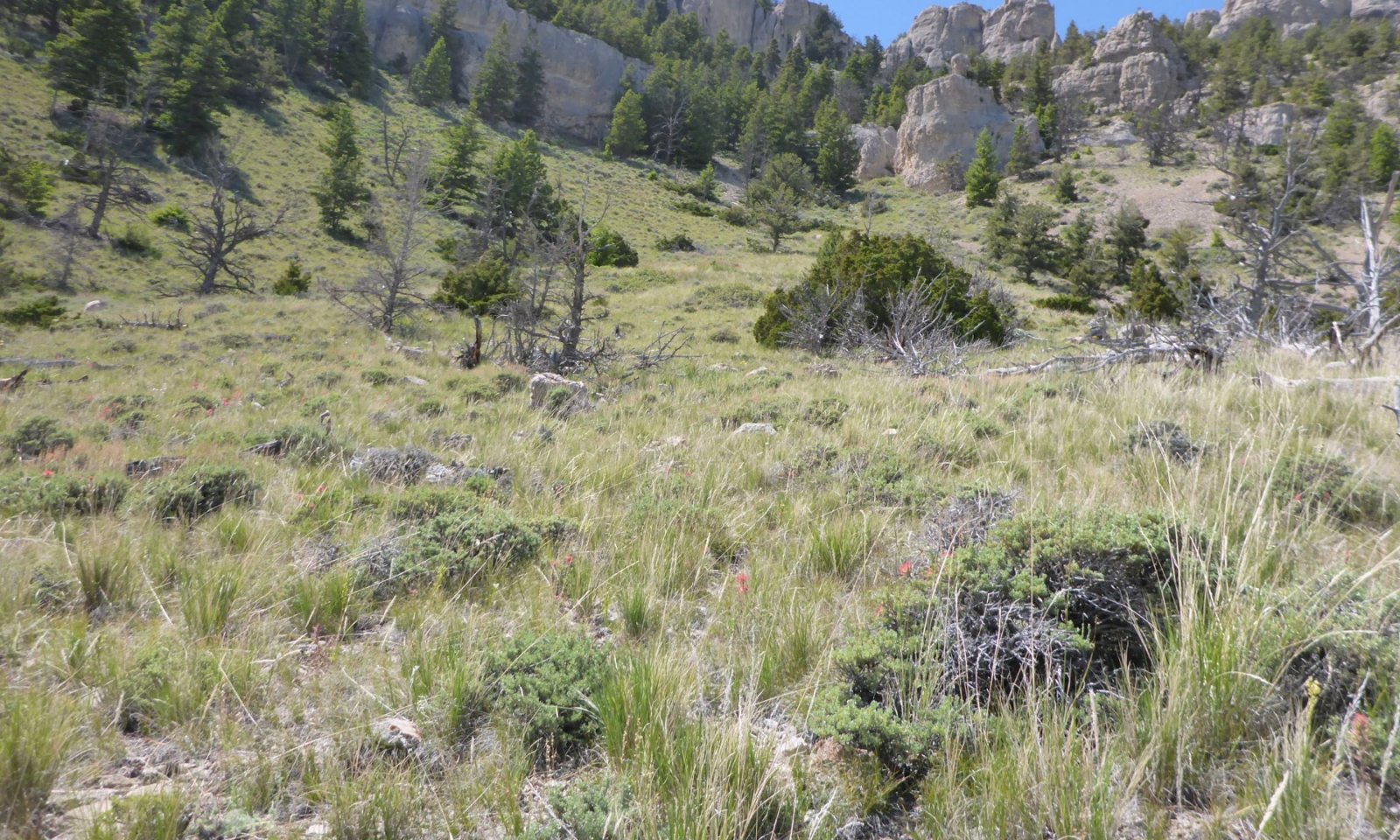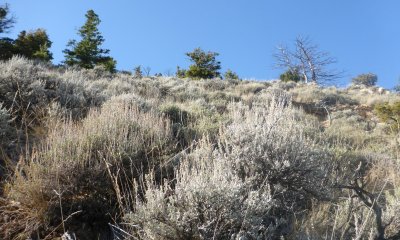
Limy Skeletal (LiSk) Absaroka Upper Foothills
Scenario model
Current ecosystem state
Select a state
Management practices/drivers
Select a transition or restoration pathway
-
Transition T1-2
Frequent and severe grazing with the change in fire frequency, drought, and other significant impacts to the herbaceous cover force this transition.
More details -
Transition T1-3
Fire, drought, and other major disturbances with a seed source present aid in this transition.
More details -
Restoration pathway R2-1
Prescribed grazing with rest or deferment and time will allow recovery of this site. Brush management will assist the process.
More details -
Transition T2-3
Continued frequent and severe use patterns, significant soil disturbance, drought, and other catastrophic events with a seed source present will transition this site to the Invaded State.
More details -
Restoration pathway R3-4
An integrated weed management plan with a native seeding and long-term prescribed grazing aids the transition of this site.
More details -
Transition T4-3
Lack of management, continued disturbance, failure of a reclamation process, or catastrophic events with seed source present will transition this community to the invaded state.
More details -
No transition or restoration pathway between the selected states has been described
Target ecosystem state
Select a state
State 1
Bluebunch Wheatgrass/Idaho Fescue/Sagebrush



Description
The Bluebunch Wheatgrass/Idaho Fescue/Sagebrush State (State 1) is the reference community for the Limy Skeletal ecological site. The diverse mix of perennial grasses, and forbs make for a productive and stable site.
Characteristics and indicators
Bluebunch wheatgrass is the dominant herbaceous species on this site with an intermixed composition of mountain big sagebrush and black sagebrush providing the dominant woody cover. Lichen common in this community with ground covering forbs.
Resilience management
The vegetation that thrives in the harsh conditions of the Limy Skeletal ecological site create a plant community resistant to change. But once disturbed, the shift in the perennial grasses and shift in shrubs is difficult and takes time to recover, reducing the resiliency of the community.
Submodel
Description
After significant pressure on the herbaceous understory and with the lack of fire to rejuvenate the woody component, this State has shifted to a short-stature cool-season grasses with shrubs becoming a significant component of this state. Some of the preferred grasses have been reduced or are absent, and forbs (ground covering) have increased in the community.
When compared to the Reference State, sagebrush, native bluegrasses, prairie junegrass, and rhizomatous wheatgrasses have increased. Most of the preferred grasses have been reduced and some are absent.
Characteristics and indicators
Dominant grasses include rhizomatous wheatgrasses, letterman's needlegrass, prairie junegrass, and of less frequency Columbia needlegrass, spike fescue, Idaho fescue and bluebunch wheatgrass. Grasses of secondary importance include slender wheatgrass, spike trisetum, one-spike oatgrass, and bluegrasses.
Forbs commonly found in this plant community include balsamroot, agoseris, buckwheat, arnica, phlox, lupine, asters, and pussytoes. Fringed sagewort, mountain big sagebrush, black sagebrush, and juniper can make up to 30% of the total annual production.
Resilience management
This State is resistant to change without a major disturbance or inputs to start the change. But it is also at risk of degrading further and is susceptible to invasion due to the decreased herbaceous cover and increased woody structure.
Submodel
Description
Any disturbance provides an opportunity for aggressive species, such as many of our introduced invaders, to establish in a community. Catastrophic events or natural climatic events (drought, wildfire, etc) can be a source of this invasion.
Characteristics and indicators
The major indication of entering this State is the abundant or significant presence of an introduced species, whether invasive or just an invader. To meet the terms of abundant or significant, the presence has to account for greater than or equal to ten percent cover of the community. Species considered in this category are Kentucky bluegrass, smooth brome, or timothy for non-native invaders; or cheatgrass for invasive species. Thistle and common dandelion are other species of concern on this ecological site.
Resilience management
Once established, these aggressive and persistent species will exclude many of the native species and are extremely difficult to reduce or remove from the community. These species are able to tolerate repeated abuse and drastic climatic swings without losing their foothold in the community, creating a resistant and resilient community.
Submodel
Description
Although to a much smaller extent than in lower elevations, there are areas that have been excavated for gravel, or have been accessed for irrigation convenience ditches or were part of a homestead. These areas have remnants of introduced species for haylands or have been left to recover and may be in at varying stages of succession. Or there are areas that are heavily impacted by recreational vehicles, parking, trails, roadways, or other land disturbances that have reduced or removed most native perennial vegetation and left a highly disturbed land.
The Disturbed State could be drafted as a stand-alone box within the state and transition model diagram. No matter what state a site originally is ranked in, once the site is mechanically disturbed, or suffers a catastrophic or significant natural disaster that alters the soil properties (erosional, depositional, hydrological or chemical), the site potential is altered.
Mechanical disturbances and reclamation practices using non-native species could qualify some stages of this state to be considered as a land use shift. The result is the shift in potential and response in management so that it is no longer similar to the reference community. The potential shifts are highly variable, so a dynamic state was captured to highlight the altered communities that exist on the landscape.
Characteristics and indicators
The soil disturbance and mechanical or physical removal of the vegetative canopy is the key characteristic of the Disturbed State. The initial indicators are the primary successional species that establish following a disturbance including Russian thistle, kochia, six weeks fescue, and sunflowers. These initial colonizers will then be followed by any seeded species, or other species from within the locations seed bank.
Resilience management
The Disturbed State is highly variable and in a state of flux as the successional processes occur. Continued disturbance of these communities is a potential threat; and the communities are at high risk of transitioning to the Invaded State.
Submodel
Transition T1-2


Mechanism
Heavy, continuous, season-long grazing plus no fires or altered fire frequency will convert the plant community to the Mixed Shrub/Perennial Grasses State. This is especially evident on areas where drought or heavy browsing has adversely impact the shrub stand. The impacts required to force this transition are significant, and this does not happen in a short time period.
Constraints to recovery
The loss of sagebrush in some of these communities and the lack of necessary seed bank and recovery time are limiting factors for this State to recover.
Context dependence
The probability of this occurring is dependent on the density of Idaho fescue in the community, the shifts in use patterns historically, and the specific soil characteristics.
Mechanism
Fire, wild or prescribed, with no change in grazing management and seed source present allows for a rapid transition to the Invaded State. Drought or other catastrophic events will aid in this transition.
Constraints to recovery
The lack of effective treatment to eradicate or significantly control invasive species long term or to remove non-native species without impact to the native community limit the recovery of this State.
Restoration pathway R2-1


Mechanism
Prescribed grazing will convert this plant community to the Reference State, with time. The probability of this occurring is high especially if rotational grazing along with short deferred grazing is implemented as part of prescribed method of use. In addition, the removal of fire suppression will allow a somewhat natural fire regime to reoccur to more easily transition between this plant community and the Reference State. A prescribed fire treatment can be useful to hasten this transition if desired, or other means of brush management.
Relevant conservation practices
| Practice | External resources |
|---|---|
|
Brush Management |
|
|
Critical Area Planting |
|
|
Prescribed Grazing |
|
|
Grazing Land Mechanical Treatment |
Mechanism
Drought, soil disturbances, or high-intensity grazing with a seed source present can open the soil surface and weaken the sod allowing invasive species to establish. Fire is a primary means of provide the niche for cheatgrass to establish on this site.
Constraints to recovery
The nature of non-native (introduced) as well as invasive species, especially cheatgrass, once they are established, they are prolific reproducers and are hardy plants, making it costly and difficult (if even possible) to remove. The lack of key grass species also limits recover of this site.
Mechanism
Integrated Pest Management, with Seeding the site to a native mixture - Success is not known to have occurred, and is rated to be low and highly variable for the rate of control of most species. Cheatgrass is one of the most invasive species for many of these sites, although there are other challenges. With intensive weed control and inputs this community can resemble an at-risk community within the reference state, but it is not possible to reach the reference community condition once there is a significant composition of non-native and invasive species that have established on a site.
Relevant conservation practices
| Practice | External resources |
|---|---|
|
Critical Area Planting |
|
|
Prescribed Grazing |
|
|
Grazing Land Mechanical Treatment |
|
|
Range Planting |
|
|
Heavy Use Area Protection |
|
|
Integrated Pest Management (IPM) |
|
|
Upland Wildlife Habitat Management |
Mechanism
Lack of management resulting in continued disturbance, catastrophic events, or failure in the restoration process are major causes for a disturbed or altered landscape to transition to an invaded state.
Constraints to recovery
The change in the soils and potentially the hydrology of the site as well as the presence on invasive species limit the recovery potential of this community.
Context dependence
Many of the altered landscapes may have non-native species initially, but the significant alteration of the soils with tillage or back-fill (pit reclamation) change the management response and hydrology of this ecological site.
Model keys
Briefcase
Add ecological sites and Major Land Resource Areas to your briefcase by clicking on the briefcase (![]() ) icon wherever it occurs. Drag and drop items to reorder. Cookies are used to store briefcase items between browsing sessions. Because of this, the number of items that can be added to your briefcase is limited, and briefcase items added on one device and browser cannot be accessed from another device or browser. Users who do not wish to place cookies on their devices should not use the briefcase tool. Briefcase cookies serve no other purpose than described here and are deleted whenever browsing history is cleared.
) icon wherever it occurs. Drag and drop items to reorder. Cookies are used to store briefcase items between browsing sessions. Because of this, the number of items that can be added to your briefcase is limited, and briefcase items added on one device and browser cannot be accessed from another device or browser. Users who do not wish to place cookies on their devices should not use the briefcase tool. Briefcase cookies serve no other purpose than described here and are deleted whenever browsing history is cleared.
Ecological sites
Major Land Resource Areas
The Ecosystem Dynamics Interpretive Tool is an information system framework developed by the USDA-ARS Jornada Experimental Range, USDA Natural Resources Conservation Service, and New Mexico State University.
